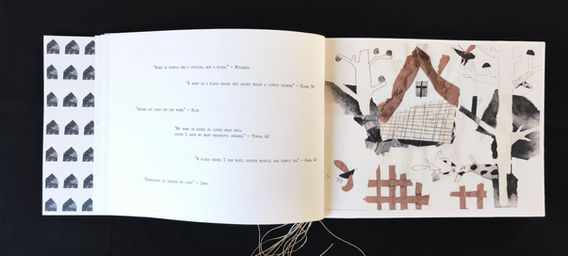
-
WHERE IS MY HOME is an artist’s book about searching for home as a state of being rather than an address.
The book gathers voices: my collages and handwritten fragments, people’s answers to the question “Home is…”, philosophical and poetic quotations, and personal texts on safety (trygghet), the room-tower, the “dome of time” after loss, and objects as carriers of memory. -
Visually, it is a handmade construction: different types of paper, tracing paper, “pockets” with texts, fragments in English for verification. On the level of meaning, it follows a movement from the external to the internal: from “trying on” other people’s homes to building one’s own — with small bricks (a pillow, a blanket, a door, a voice).
The leitmotif of the project: “Home is you / You are the house.”
What this project is about
The project was born from an insistent question: what is “home” when the word has stopped being felt in the body? A void appeared, a refusal to return to the past, and a lack of understanding of what “I” even is. On the surface — familiar images: walls, furniture, smells. But beneath them lie other layers: safety and its reverse side, the child’s “room-tower” as a self-portrait of boundaries, the home after loss as a dome of suspended time, objects that continue to hold phantom memory.
Out of this search came a practical path: to build an inner home from small bricks — object-rituals and the right “to be” (a pillow for safe tears, a blanket chosen by myself, a door I can close, an inner voice saying: “You have the right”). The book ends in silence and a simple phrase: “Home is you.”
Method and form
This is not a document and not a memoir. It is a container-space for questions, reflections, and responses. I allowed myself to let go of structure and perfection, leaving room for breath and pause. The illustrations are my collages, without archival photographs: windows, room-scenes, abstract domes, objects as characters.
For me, feelings always come first: images and visual scenes are born, and only later do words help decipher them. The format of the illustrations became the starting point for my reflections. It was an unconscious process, without understanding or goal. Images arranged themselves into narratives and pain. In this space, they serve as my silent answers in dialogue with other people.
Themes of the book
-
Voices / “Home is…” — a multilingual header, a flow of definitions, and survey quotes. Not an answer, but an open field of possible meanings.
-
Trygghet / Safety — a reflection on why “safety” is the word most often named, on the difference between survival and inner calm, on the right “to be.”
-
The Room-Tower — the child’s room as a self-portrait of boundaries; the tower as temporary protection and anchor.
-
Home After… / Dome of Time — entering an empty house after loss; phantom memory of objects; objects as carriers of energy.
-
Searching for One’s Own Home — a series of visual and textual “try-ons” of other people’s spaces (like a sweater in a fitting room), where imagination meets the reality of “living out of a suitcase.” Gradually this line leads to a practical path: building an inner home with small bricks — pillow, blanket, door, voice. The final point is silence and the phrase “Home is you / You are the house.”



These collages are fragments of an inner dialogue about home.
They weave together abstract images and personal memories, turning space into a metaphor of protection, loss, and search.
Each of them is like a small “house,” holding memory and feeling.

Influences: Arendt, Bachelard, Baldwin, Barthes, Bashraheel, Baudrillard, Berger, Calvino, Dessen, Dickens, Faulkner, Foucault, Graham, Jung, Keller, Lahiri, Lewicka, Mahfouz, Mankell, McManus, Merleau-Ponty, Moore, Morgenstern, Merton, Ovid, Plath, Proust, Rilke, Rowland, Rushdie, Scannell & Gifford, Shire, Weil, Wikipedia contributors, Winnicott.





































